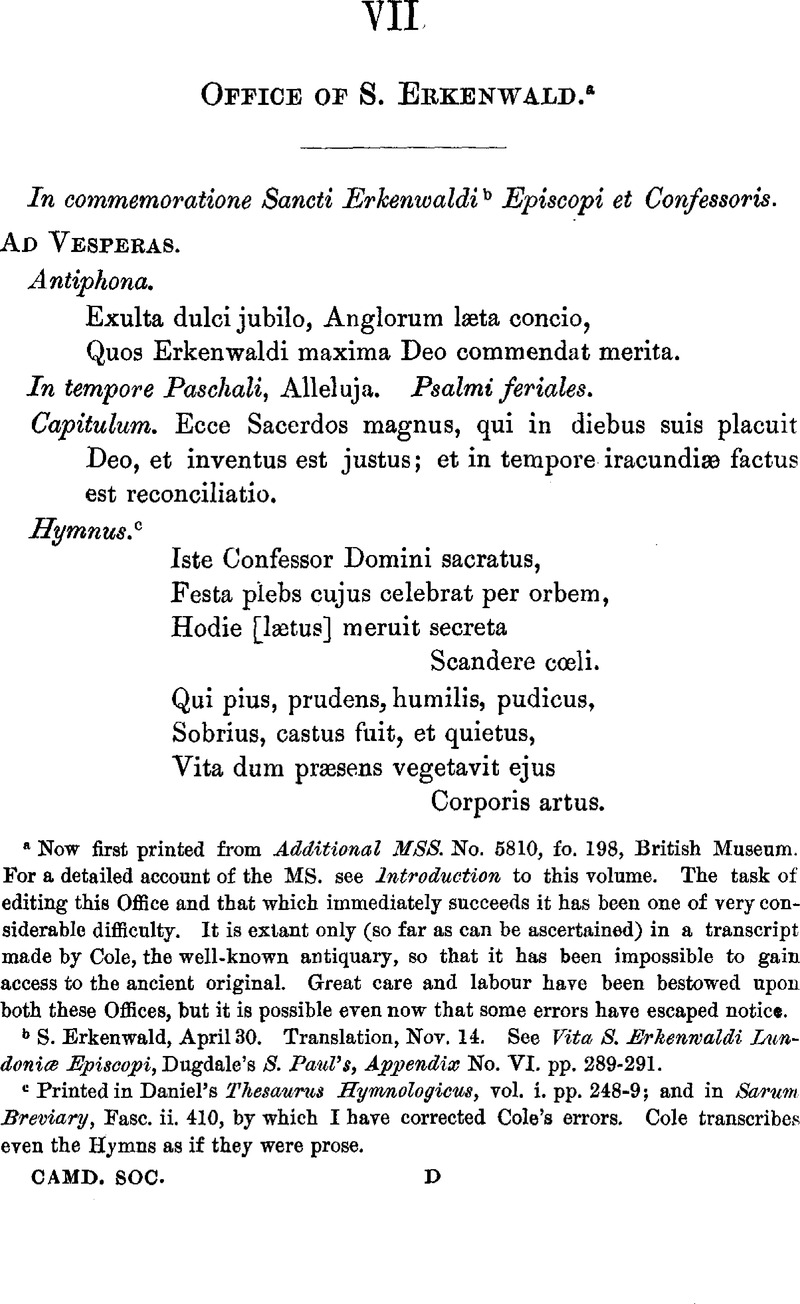No CrossRef data available.
Article contents
Abstract

- Type
- Documents
- Information
- Camden New Series , Volume 26: Documents Illustrating the History of S. Paul's Cathedral , March 1881 , pp. 17 - 24
- Copyright
- Copyright © Royal Historical Society 1881
References
page 17 note b S. Erkenwald, April 30. Translation, Nov. 14. See Vita S. Erkenwaldi Lundoniœ Episcopi, Dugdale, 's S. Paul's, Appendix No. VI. pp. 289–291.Google Scholar
page 17 note c Printed in Daniel's Thesaurus Hymnologicus, vol. i. pp. 248–9Google Scholar; and in Sarum Breviary, Fasc. ii. 410Google Scholar, by which I have corrected Cole's errors. Cole transcribes even the Hymns as if they were prose.
page 18 note a Daniel, , membrum fueritGoogle Scholar; Cole, , fuerint.Google Scholar
page 18 note b Cole, , restituunt.Google Scholar
page 18 note c Sarum Breviary, gubernat.
page 18 note d Sarum Breviary, col. 410. The response is, Stola gloriæ induit eum.
page 19 note a Antiphons, even when rhythmical in structure, like the present, are printed as prose.
page 19 note b S. Erkenwald founded religious houses at Chertsey and at Barking. “Hic fecit duo monasteria, unum sibi, alterum sorori. Suum Certesei [Chertsey] dicitur, quod amminiculo Frithewoldi subreguli opulentia rerum et monachis implevit. Sororis cœnobium appellatur Berkingum [Barking], ubi ipsa prima abbatissa fuit.“— Hintorical Works of R. de Diceto, edited by Professor Stubbs, i. 115.Google Scholar
page 20 note a This Antiphon is very obscure. Some approach to a better sense might be made by printing part of it thus: “prædicandi tempore, servatum multo indicat populo,” &c; but the text accurately represents the MS.
page 20 note b Caballarium feretrum: species lecticæ seu rhedæ caballis vectæ. Caballus, equus. Ducange. The three lections are taken almost verbatim from Capgrave's Acta S. Erkenwaldi, printed in the Acta Sanctorum for April 30, p. 791. A short Life of S. Krkenwald, in English, will be found in Appendix E.
page 20 note c MS. remeante, erroneously.
page 21 note a Daniel, , Thesaurus Hymnologicus, i. 249, 250Google Scholar; and Sarum Breviary, Fasc. ii. 420.Google Scholar
page 21 note b Daniel, , lœtisGoogle Scholar; Sarum Brev. lœtus, as in text.
page 21 note c Cole and Sarum Breviary, benigne; Daniel, , benignus.Google Scholar
page 21 note d MS. noxiam, erroneously.
page 22 note a Compare similar Versicle in Sarum Breviary; the Response is, Et florebit in æternum ante Dominum.
page 23 note a The full Versicle is, Triatitia vestra vertetur in gaudium.—Sarum Breviary.
page 23 note b Has, so in MS. but probably we should read alias.
page 23 note c Qua, so in MS. probably for tua.
page 24 note a Not in Cole's MS. I have introduced it from Bishop Braybrooke's Monitio.
page 24 note b A fine chasuble “de panno Tarsico, Indici coloris, cum pisciculis et rosulis aureis et lato aurifrigio, optime operato cum ymaginibus et scutis, et dorsali consimili,” was presented to the cathedral by J. de S. Claro, who desired that it should be used on the feast of All Saints and on that of S. Erkenwald.—Dugdale, 323. See also Dugdale, 318, 319, 321.




